zeolite adsorbent zeolite is a silicate mineral water containing aluminum frame structure
2014年11月29日星期六
Japan CDS-1 successfully developed a new type of molecular sieve
Recently, Xiao Bian understand a message from the Japanese National Institute of Advanced Industrial Science and Technology (AIST) synthesis of a novel zeolite CDS-1 has been successfully developed.
It was prepared by a layered silicate, has a unique structure - by molecular stacking blocks. According to the institute, said the film chemistry lab, CDS-1 between its silicate layers has many pores. Research center will work processing CDS-1 into the film, mainly used for the separation agent catalyst. Typically, the use of a structure-directing agent (Structure-directing agent) complex can be formed by hydrothermal synthesis of nanosized pore size. These pores may be at about 420 ℃, using condensation polymerization method easily and economically be bonded together to form a silicate layer.
This made one molecular structure but retain the layered silicate framework is without precedent. Molecular sieves containing silicon, aluminum and oxygen atoms. When the silica-alumina composite containing a high proportion of silicon, called a high-silica zeolite molecular sieve. This kind of molecular sieve is hydrophobic and high temperature. AIST has a molecular sieve such intellectual property rights, the Department of silicon and oxygen by a silicate system. It is resistant to high temperature above 800 ℃ and chemical resistance. When immersed in a solution of an acid or a base, and still retains its original structure.
订阅:
博文 (Atom)

